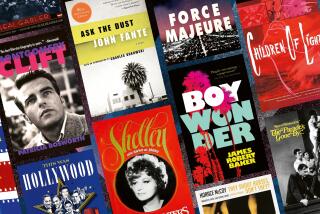A Rewrite for Hollywood’s Blacklist Saga
For more than 50 years, the communists and former communists of Hollywood have written the script of the past, telling the story of the blacklist in memoirs and histories, movies and documentaries in which they depict themselves as noble martyrs and champions of democracy. It is time, finally, to put an end to the glorification of this unhappy period and take a cleareyed look at the Hollywood Ten, the blacklist and the movie industry Reds who wielded such influence in the 1930s and 1940s.
According to the familiar but utterly romanticized script, the screenwriters, directors and actors who flirted with and joined the Communist Party are unadulterated heroes -- just “liberals in a hurry.” It is a simple black-and-white tale, as they tell it: The villains were the Hollywood moguls who blacklisted them, the liberals who abandoned the fight, and most of all, the “friendly” ex-communist witnesses who testified about their lives in the party and named names of old associates to the House Un-American Activities Committee.
It is a fable that has acquired an almost irresistible weight as a result of half a century of telling and retelling. Read Lillian Hellman. Or go see the Irwin Winkler film “Guilty by Suspicion.”
But is it true? Certainly the blacklist harmed the careers of some of Hollywood’s finest. Its damage extended not only to actual party members but, in some cases, to the well-meaning who joined party-controlled “popular front” organizations. But the accepted narrative obscures the important truth about communist influence in Hollywood. The Hollywood Ten were among the most committed of the party faithful, yet they’ve been wrapped and protected in a romantic haze, allowed to wear their appearance before HUAC as a badge of honor. The blacklist was a godsend, enabling them to reinvent themselves as heroic victims rather than what they really were: die-hard defenders of Josef Stalin who accepted every twist and turn of the party line, whether it was the Nazi-Soviet Pact, the invasion of Finland or the purge trials.
The truth is that, by the time HUAC arrived on the scene in 1947, the communists had already worn out their welcome in Hollywood. Liberals such as Melvyn Douglas felt betrayed at the time of the Nazi-Soviet Pact, when the communists suddenly transformed the “Anti-Nazi League” into the “Hollywood Peace Forum,” calling for American neutrality and using the slogan “Let’s Skip the Next War.” When the Cold War began, liberals such as Olivia De Haviland were already breaking from the party’s main wartime front group, arguing against unity with those “who are more interested in taking orders from Moscow and following the so-called party line.”
Today, we seem to have forgotten the credible reasons that led some disillusioned former communists to reluctantly appear as friendly witnesses before HUAC. Budd Schulberg talked about how his Hollywood comrades did everything possible to stop him from working on his first novel, “What Makes Sammy Run?,” because it deviated from the party line. The great director Elia Kazan told how the party created a secret cell that sought to take over the Group Theater. Others talked about how the party attacked screenwriter Albert Maltz for daring to write that perhaps art was more than just a “weapon.”
The blacklist was an abomination. It was wrong to deprive artists of their livelihood because of their political views. But its most malicious contribution to postwar history was to obscure forever the truth about communism in Hollywood. The most astute former blacklisted screenwriter came to understand this. Dalton Trumbo explained that it was the party’s “secret” organizational structure that gave rise to the blacklist. The Reds, Trumbo wrote, “should have all been open communists, or they should not have been members at all.”
Trumbo’s own son, Christopher, has mythologized his father in his recent play, “Trumbo: Red, White and Blacklisted.” To this day, few know anything about Trumbo’s willingness to befriend the hated “informers,” or how he ultimately realized that he and his comrades had been used by the party leadership. In 1970, he gave a startling speech when he accepted a career achievement award from the Writers Guild. “It will do no good to search for villains or heroes or saints or devils because there were none,” Trumbo said that night. “There were only victims.”
Despite that, the mythology continues today, exemplifying John Ford’s maxim: When there is a conflict between the truth and the myth, go with the myth.
More to Read
Only good movies
Get the Indie Focus newsletter, Mark Olsen's weekly guide to the world of cinema.
You may occasionally receive promotional content from the Los Angeles Times.










